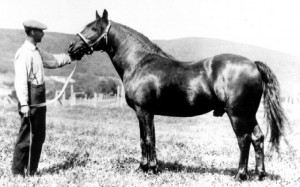With the same line of reasoning for the “King’s Daughters” being brought over to New France in the seventeenth century, King Louis XIV also brought horses from his personal stables. This foundational horse would become what is known as the French-Canadian horse. This distinctly Canadian breed was contemporarily described as “low-sized . . . his demeanor proud and courageous . . . [and] an indefatigable undaunted traveller, with the greatest endurance, day in and day out” (Jones 131).
An extremely hardy breed, the French-Canadian horse was a valuable general-purpose animal to be used on the winter roads of Lower Canada and in light farm work. The French-Canadian horse was also highly sought after as a lucrative animal in the business of trade and auctioned for as little as $700; however, this sum was quite substantial for the mid to late 1800s (142).
While the old French-Canadian horse disappeared as a distinct race toward the end of the nineteenth century, its ancestry continues to be evident in the common horses found today in the Maritime Provinces, New York, Michigan, and Illinois (154). Surpassed only by the Thoroughbred as a contributor to the development of the leading American horses, the French-Canadian horse, despite the extinction of the pure breed, is worthy of acknowledgement by breeders, historians, and horse lovers everywhere—who knows, you may be riding one of its descendants!
Michigan, and Illinois (154). Surpassed only by the Thoroughbred as a contributor to the development of the leading American horses, the French-Canadian horse, despite the extinction of the pure breed, is worthy of acknowledgement by breeders, historians, and horse lovers everywhere—who knows, you may be riding one of its descendants!
Interested in learning more about Canada’s founding horse or Canadian livestock in general? Consider purchasing Robert Leslie Jones’ article “The Old French-Canadian Horse: Its History in Canada and the United States,” published by the Canadian Historical Review in 1947, or subscribing to the Canadian Historical Review to get full access to the journal’s archives and its most recent historical scholarship.

Comments on this entry are closed.